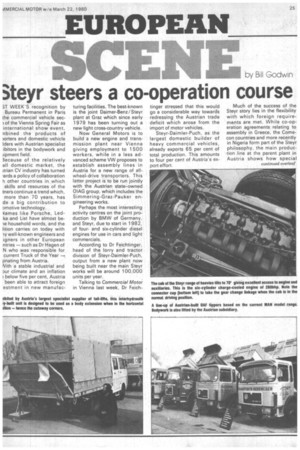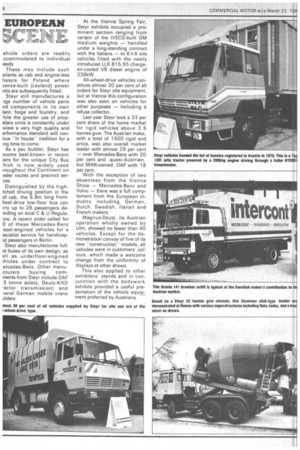by BM Godwin
Page 27

Page 28

If you've noticed an error in this article please click here to report it so we can fix it.
3teyr steers a co-operation course
ST WEEK'S recognition by Bureau Permanent in Paris the commercial vehicle secof the Vienna Spring Fair as international show event, nbined the products of )orters and domestic vehicle Iders with Austrian specialist ibitors in the bodywork and iipment field.
3ecause of the relatively all domestic market, the itrian CV industry has turned 'ards a policy of collaboration h other countries in which skills and resources of the triers continue a trend which, more than 70 years, has de a big contribution to amotive technology.
%James like Porsche, Ledka and List have almost bele household words, and the lition carries on today with well-known engineers and igners in other European ntries — such as Dr Hagen of N who was responsible for current Truck of the Year — jinating from Austria,
+Vith a stable industrial and Du r climate and an inflation below five per cent, Austria been able to attract foreign estrnent in new manufac
turing facilities. The best-known is the joint Daimer-Benz /Steyr plant at Graz which since early 1979 has been turning out a new light cross-country vehicle.
Now General Motors is to build a new engine and transmission plant near Vienna giving employment to 1500 workers, while in a less advanced scheme VW proposes to establish assembly lines in Austria for a new range of allwheel-drive transporters. This latter project is-to be run jointly with the Austrian state-owned OIAG group, which includes the Simmering-Graz-Pauker en7 gineering works.
Perhaps the most interesting activity centres on the joint production by BMW of Germany, and Steyr, due to start in 1982; of fourand six-cylinder diesel. engines for use in cars and light commercials.
According to Dr Feichtinger, head of the lorry and tractor division of Steyr-Daimler-Puch, output from a new plant now being built near the main Steyr works will be around 100,000 units per year.
Talking to Commercial Motor in Vienna last week, Dr Feich
tinger stressed that this would go a considerable way towards redressing the Austrian trade deficit which arose from the import of motor vehicles.
Steyr-Daimler-Puch, as the largest domestic builder of heavy commercial vehicles, already exports 65 per cent of total production. This amounts to four per cent of Austria's export effort. Much of the success of the Steyr story lies in the flexibility with which foreign requirements are met. While co-operation agreements relating to assembly in Greece, the Comecon countries and more recently in Nigeria form part of the Steyr philosophy, the main produc.tion line at the parent plant in Austria shows how special ehicle orders are readily ccommodated to individual leeds.
These may include such 3riants as cab and engine-less hassis for Poland where cence-built (Leyland) power nits are subsequently fitted. Steyr still manufactures a rge number of vehicle parts nd components in its own lant, forge and foundry, and 'hile the greater use of propetary units is constantly under ;view a very high quality and erformance standard will connue "in housetradition for a mg time to come.
As a psv builder, Steyr has 3come best-known in recent ;ars for the unique City Bus hich is now widely used iroughout the Continent on odor routes and precinct serces.
Distinguished by the hightched driving position in the ilf cab, the 5.8m long frontheel-drive low-floor bus can irry up to 28 passengers demding on local C & U Regulaans. A recent order called for 0 of these Mercedes-Benz esel-engined vehicles for a )ecialist service for handicapKI passengers in Berlin.
Steyr also manufactures full!e buses of its own design, as ell as underfloor-engined :hides under contract to ercedes-Benz. Other menu
cturers buying cornments from Steyr include DAF 3 tonne axles), Deutz-KHD -actor transmission) and veral German mobile crane iilders.
At the Vienna Spring Fair, Steyr exhibits occupied a prominent section ranging from certain of the IVECO-built OM medium weights — handled under a long-standing contract with the Italians — to 6 X 6 site vehicles fitted with the newly introduced LLK 815.65 chargeair-cooled V8 diesel engine of 236kW.
All-wheel-drive vehicles constitute almost 30 per cent of all orders for Steyr site equipment, but at Vienna this configuration was also seen on vehicles for other purposes — including a refuse collector.
Last year Steyr took a 33 per cent share of the home market for rigid vehicles above 3.5 tonnes gvw. The Austrian make, with a total of 1 500 rigid and artics, was also overall market leader with almost 29 per cent — over Mercedes-Benz with 20 per cent and .quasi-Austrian, but MAN-owned, OAF with 18 per cent.
With the exception of two absentees from the Vienna Show — Mercedes-Benz and Volvo — there was a full complement from the European industry including German, Dutch, Swedish, Italian and French makers.
Magirus-Deutz, its Austrian operation wholly owned by Ulm, showed no fewer than 40 vehicles. Except for the demonstration convoy of five of its new "construction'' models, all vehicles were in customers' col= ours, which made a welcome change from the uniformity of displays at other shows.
This also applied to other exhibitors' stands and in conjunction with the bodywork exhibits provided a useful presentation of the vehicle equipment preferred by Austrians.
































































































































